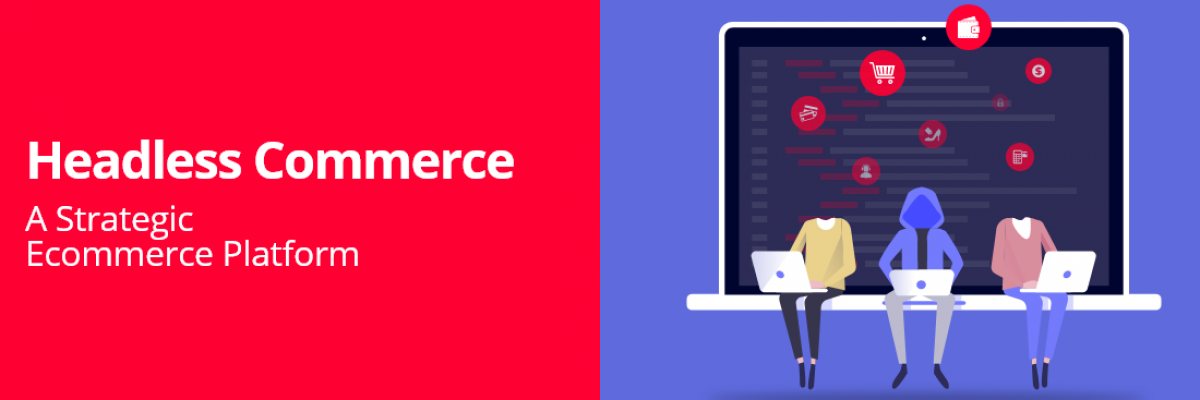Headless Commerce: A Strategic Ecommerce Platform
It is evident that ecommerce business is opening the doors of opportunity to countless entrepreneurs. You may also know ecommerce websites like Amazon have crossed $1 trillion in market value.
But did you ever wonder what is special with ecommerce sites like Amazon, Alibaba, etc.? The one common thing with them is providing a better customer service along with impressive user experience.
So, what makes them better at providing customer service? Is there any strategy to have a highly responsible ecommerce website?
Headless Commerce is one of the strategic techniques to give retailers development flexibility and faster time to market. Its architecture allows for decoupling the front-end and back-end, wherein they can stand independently to one another.
In this article, you will get to know how headless commerce offers more flexibility in the ecommerce platform by separating the content layer from the functional layer.
Headless Commerce vs Traditional Commerce
Traditional Commerce
Traditional commerce is also called as a monolithic model. The word monolithic itself tells that it is a single large unit where there will be no separation. Here, you won’t be able to separate both the front end and back end of the ecommerce system. If there is a change in the front-end it will be reflected in the back-end also, concurrently.
The traditional commerce offers only simple presentation and appearance for the website and there is also some design constraint. It’s a massive process to edit or write new code for the platform from the back-end.
Personalization and customization require a pre-defined strategy for both user and admin. Modification in front-end code requires a change in back-end code which is also a time-consuming process.
It restricts the type of content that users can post such as videos or imagery. If any small error in back-end results in performance issues. It requires maintenance to make the website live.
Headless Commerce
Headless Commerce provides a separate non-interfering platform for both front-end and back-end developers to develop codes. Here front-end developers create a user interface and back end developers create content and store them which is needed to be present in the user interface.
This approach helps in decoupling the front-end or presentation layer of the ecommerce platform and the rest of the system for creating rich content and a better experience for the user.
It can efficiently manage the content that is present on the website and delivers it to any channel. They share the content through the APIs which makes the content available for any devices and channels. When you have headless commerce, it's easy to provide a customized user experience without back-end support. You can provide any type of content that you want on your ecommerce website since the front-end is decoded from the back-end.
How does Headless Commerce work?
Back-end services and content management system in headless commerce is not bounded with the user interface layer so when UI needed some content or information, it is communicated through APIs.
This technique makes the developer create multiple unique interfaces and custom-built storefront for various platforms without modifying the back-end services that has the necessary content for the website.
For example, when a person/customer wants to know the product details they can just click the know more. All the functions related to know more presented in front-end and it only sends an API to the back-end to collect data. Also, the most important thing is headless commerce’s architecture is built on the Internet of Things (IoT).
Features of Headless Commerce
Faster development: Ecommerce website requires frequent changes in the design and content that present in the webpages. New functions and changes in the front-end can be made without disturbing the back-end and vice versa.
Page loading will be also faster since content can be cached in the cache layer that helps to support more traffic.
Omni-Channel Capability: Headless commerce helps in pushing your content anywhere at any time and deliveries product details, videos, blogs to any channels like desktop, mobile, web, etc. The major thing is you need not to re-architecture your platform to support all the channels.
Personalized experience: Ecommerce is the more competitive business place where technologies, innovation, and trends change rapidly. Personalization is the key to run a successful ecommerce business. With the help of a headless commerce system, you can experiment the personalization without disturbing the user interface.
Customization and integration: Customization and integration with other functionalities are much easier with headless commerce. As these architecture integrations are no longer a package deal, you don’t have to buy them in bulk.
When front-end and back-end remains a two separate system, customizations can be done in parallel. And with the help of integration, you can engage the customer in the ecommerce site.
Flexibility: Headless commerce decouples the front-end and back-end, which allows for flexibility and customization to make whatever modifications you want, and only requires a front-end developer. You can even make a big change like integrating the checkout process with payment easily.
Optimization: Decoupling the front-end and back-end allows you to run continuous tests and optimization that help in getting a better understanding of your customer.
A strategic ecommerce platform
Headless Commerce helps your ecommerce site to improve in many ways. Here time is a valuable thing, headless commerce reduces the dependency and development time of the process. Only a few of the ecommerce websites have developed using headless commerce. Purchase Commerce already understood the importance of headless commerce and offers the next-gen ecommerce platform which supports headless commerce.








